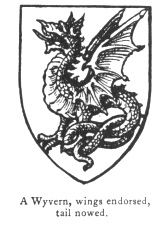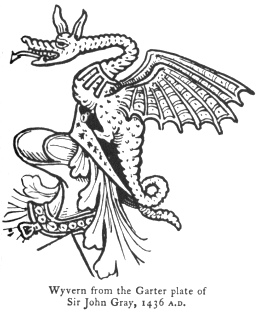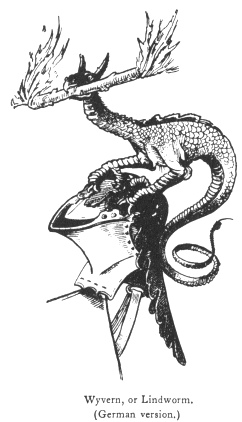
Sacred Texts Legendary Creatures Symbolism Index Previous Next
Buy this Book at Amazon.com


Fictitious and Symbolic Creatures in Art, by John Vinycomb, [1909], at sacred-texts.com
(Saxon, Wivere, a serpent) said to represent a flying serpent, an imaginary creature resembling the dragon, but having only two legs, which are like an
eagle's, and a serpent-like tail, barbed, sometimes represented nowed after the manner of serpents. It is figured on one of the
 |
 |
Occasionally a wyvern is borne with the tail nowed and without wings.
Lindworm.—It is not usual to say a wyvern "without wings" or "without legs," but sans wings or sans legs, as the
case may be. A dragon or wyvern sans wings is termed a lindworm. (See page 80.)
Argent, a wyvern, wings endorsed gules, are the arms
 |
The town of Leicester has for crest a wyvern, wings expanded, sans legs, strewed with wounds, gules.
Argent on a bend sable, between two lions rampant of the last, a wyvern volant in bend of the field, langued gules, Ruddings.
Two wyverns, wings endorsed and emitting flames, are the supporters of Viscount Arbuthnot.
The arms of the King of Portugal are supported by two wyverns erect on their tails or, each holding a banner, the crest is a demi-wyvern out of a ducal coronet.
Guivre.—The wyvern or serpent in the arms of the Visconti, Lords of Milan, argent a guivre d’azure couronnée d’or, issante de gules (Guivre is represented as a serpent or wingless dragon sans feet, with a child's
body issuing from its mouth), is said to commemorate the victory of a lord of that house over a fiery dragon or guivre which inhabited a cavern under the church of St. Denis in that place. "It is hardly possible," says Miss Millington, "not to think that the story of the dragon as well as its adoption in the coat-of-arms
bears allusion rather to the dragon of paganism, expelled from the city, as it might seem, by the church built upon the site of the cave, in which too, by the rite of Holy Baptism, children especially were delivered from the power of Satan. Indeed, the innumerable legends of saints who have fought and overcome dragons sufficiently prove the symbolic light in which that creature was anciently viewed." (See also Serpent Biscia, p. 117.)